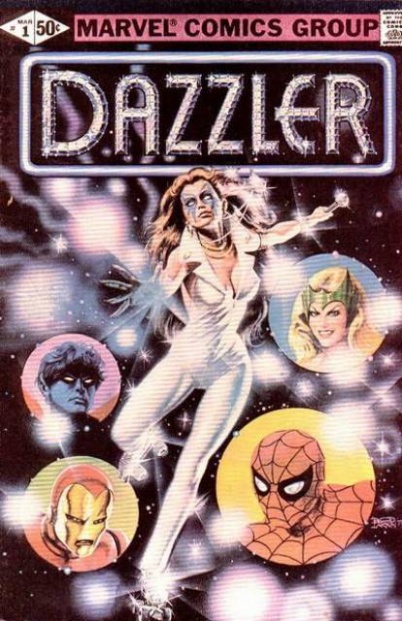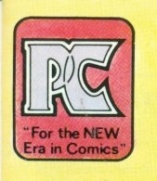This column’s article on Comic history from 1980 was so popular, it’s back with a sequel: 1981!

Industry summary
In 1981, comic books were the fourth largest collectible field in the US, behind coins, stamps, and antiques. Bagging and boarding was a standard practice, and the quality of products had greatly improved since their introduction twenty years earlier. Fantagraphics was the first publisher to try taking advantage of this audience when they created “Amazing Heroes”, the first professional magazine with the comic industry as its primary focus.
As the importance of collectors continued to rise in relation to casual readers, the industry’s big two publishers found ways to improve their package. Marvel made the switch from letterpress printing to the more expensive and higher quality offset printing early in the year, resulting in noticeably better reproduction. DC followed their lead on printing style later in the year, but was a leader on improving the presentation prior to reproduction when they hired Neal Pozner to be the first design director in the industry.
Other publishers generated less fan interest and tried ways to course correct. Harvey Comics cut their production down to their two most popular properties, Richie Rich and Hot Stuff. Western dropped their Gold Key imprint and focused on their Whitman brand, which sold bundles of comics in department stores. Whitman worked out a deal with DC to include some of their older material in the bundles, with the DC bullet replaced by the Whitman logo.
Meanwhile, the Federal Trade Commission Improvement Act removed some longstanding regulations on marketing to children, opening the door to a flood of licensed toy comics later in the decade. The next time you enjoy an issue of “Transformers” or “GI Joe,” be sure to tell Ronald Reagan thank you.

The Direct Market
By 1981, the 3000 comic specialty stores in the United States represented a significant portion of Marvel and DC’s sales. In March, Marvel experimented with their first comic exclusive to the Direct Market, “Dazzler” #1. They hedged their bets by offering later issues on newsstands as well, but they need not have done so – “Dazzler” #1 sold 400,000 copies when other titles were considered successful if they could sell half of that. DC did their own experiment in April with the one shot “Madame Xanadu,” which retailed for double the contemporary standard but still had orders around 100,000. Buoyed by the response to “Dazzler,” Marvel converted three low-selling newsstand books (“Micronauts,” “Ka-Zar,” and “Moon Knight”) to direct market-only in May 1981. House ads let readers know the DM exclusives were created for fans.
At the same time Marvel and DC were leaning into the direct market, WaRP Graphics was trying to break out of it. Wendy Pini’s black and white “ElfQuest” had been a success in the DM since its debut in 1978, with orders rising on every issue and a 55% female readership. In an effort to help readers access earlier stories, they began color reprint collections in 1981. When Walden Books began stocking them, “ElfQuest” became the first comic to migrate from the Direct Market to the book market.
Distribution
The Direct Market was supported by a thriving network of distributors, organizations that were mostly regional with a couple national ones. These distributors were in fierce competition with one another, but a few of them recognized that their practice of undercutting each other to steal clients was unsustainable. In the Summer of 1981, Direct Market founder Phil Seuling also feared that the publishers would inevitably begin offering worse deals that distributors would feel forced accept in order to remain competitive. He brought all the distribution heads together at the San Diego Comic-Con for the first meeting of the International Association of Direct Distributors.
[iamge width=424]http://multiversitystatic.s3.amazonaws.com/uploads/2021/08/Milton-Griepp.jpg[/image]The Association was a bust from the start. Milton Griepp (pictured) wanted to start a credit rating system so deadbeat retailers wouldn’t be able to switch to a new distributor when his debt grew too large with his current one. That idea floundered because it required everyone to share customer data, which would make it easier to poach them. Seuling had hoped they could collectively bargain with DC to discuss new trade terms, but most of the distributors were fans-turned-pros instead of businessmen. The majority wanted to accept whatever DC would offer because it would be easier, and because the honor of selling DC books was more valuable than selling DC’s books at a decent profit.Continued belowA few months later, at the 1981 World Science Fiction Convention, DC hand selected about half the members of the IADD to carry their products. The other half were dead in the water, losing customers until they closed.

Pacific Comics
One of the surviving distributors was Pacific Comics, run by brothers Steve and Bill Schanes. Their business was booming, with stores stocking everything Pacific offered and asking for more. Seeing the demand, the Schanes made the only reasonable decision. They began publishing their own books in November 1981, making them the first Direct Market exclusive publisher (excluding self-publishers like Dave Sim or Wendy Pini). Their first release was Jack Kirby’s “Captain Victory and the Galactic Rangers.”
How did these two young guys land an industry titan like Kirby? Part of it was location. They lived close enough to visit Kirby and establish a relationship with him. The other part was the offer: creative control, ownership, 8% royalties (10% on sales over 100,000) – basically everything Marvel and DC had denied him throughout his career. They were also printing on higher quality paper, which meant better reproduction of the artwork. It helped that his commitment was relatively minor – “Captain Victory” had been made for another publisher but funding issues meant the deal was never finalized, so Kirby had the finished pages just sitting around. The comic wasn’t Kirby’s best, and it didn’t set the world on fire, but it did make Pacific’s business model of creator-ownership look practical.
The same offer the Schanes made to Kirby was open to any other creator who was interested, and word of it spread long before “Captain Victory” hit sales racks in November. That same month, DC announced its own royalty program that would be effective in 1982. Marvel announced a similar one shortly after. Jeanette Kahn and DC have said this was in the works for years before it was announced. Jim Shooter and Marvel have said theirs was being developed before DC’s, but that upper management delayed it. Royalties were long overdue, and there’s no doubt there’s truth to both statements. However, it’s a striking coincidence that neither company was able to seal the deal until immediately after Pacific made their offer known, and a cynic wonders if royalties from the Big Two would have come as early in a world without Pacific Comics.






